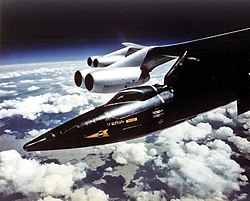1963 in spaceflight
Appearance
 A North American X-15 made two suborbital flights in July and August, becoming the first reusable spacecraft | |
| Orbital launches | |
|---|---|
| First | 4 January |
| Last | 21 December |
| Total | 70 |
| Successes | 50 |
| Failures | 17 |
| Partial failures | 3 |
| Catalogued | 55 |
| Rockets | |
| Maiden flights | Atlas LV-3A Agena-D Atlas LV-3C Centaur-B Polyot 11A59 Scout X-2B Scout X-3M Scout X-4 Thor DSV-2A Ablestar TAT SLV-2A Agena-B TAT SLV-2A Agena-D Voskhod 11A57 |
| Retirements | Atlas LV-3B Atlas LV-3C Centaur-B Scout X-2B Scout X-2M Scout X-3M |
| Crewed flights | |
| Orbital | 3 |
| Suborbital | 2 |
| Total travellers | 4 |
Deep space rendezvous
| Date (GMT) | Spacecraft | Event | Remarks |
|---|---|---|---|
| 5 April | Luna 4 | Flyby of the Moon | Failed lander, closest approach: 8,336 kilometres (5,180 mi) |
| 19 June | Mars 1 | First flyby of Mars | Closest approach: 193,000 kilometres (120,000 mi), communications system failed before flyby |
Notable creations of orbital debris
| Date/Time (UTC) | Source object | Event type | Pieces tracked | Remarks |
|---|---|---|---|---|
| 9 May[1] | Westford-2 | Communications experiment | 46[1] | As part of an experiment to facilitate international telecommunications, the US Military deployed an artificial space ring consisting of hundreds of millions of tiny copper needles[2] which would act as antennas reflecting radio signals at the target wavelength of 8 GHz. A large proportion of the needles were not dispersed properly and remained stuck in clumps that were discovered and tracked by the SSN between 1966 and 1991. As of October 2013[update], 46 of the 144 detected debris clumps remain in orbit.[1] The needles that were properly dispersed are believed to have decayed.[1]
This event prompted international protests[3][4][5][6] and influenced the drafting of the 1967 Outer Space Treaty.[3] |
Orbital launch summary
By country

|
| |||||
| Orbital launch attempts by country in 1963 | ||||||
| Country | Launches | Successes | Failures | Partial failures |
Remarks |
|---|---|---|---|---|---|
| 24 | 15 | 9 | 0 | ||
| 46 | 35 | 8 | 3 |
By rocket
By orbit
| Orbital regime | Launches | Achieved | Not Achieved | Accidentally Achieved |
Remarks |
|---|---|---|---|---|---|
| Low Earth | 57 | 44 | 13 | 2 | |
| Medium Earth | 5 | 4 | 1 | 0 | |
| High Earth | 5 | 3 | 2 | 0 | Including Highly elliptical orbits |
| Geosynchronous/transfer | 2 | 2 | 0 | 0 | |
| Heliocentric | 1 | 0 | 1 | 0 |
References
- Bergin, Chris. "NASASpaceFlight.com".
- Clark, Stephen. "Spaceflight Now".
- Kelso, T.S. "Satellite Catalog (SATCAT)". CelesTrak.[dead link]
- Krebs, Gunter. "Chronology of Space Launches".
- Kyle, Ed. "Space Launch Report". Archived from the original on 5 October 2009. Retrieved 13 August 2022.
- McDowell, Jonathan. "GCAT Orbital Launch Log".
- Pietrobon, Steven. "Steven Pietrobon's Space Archive".
- Wade, Mark. "Encyclopedia Astronautica".
- Webb, Brian. "Southwest Space Archive".
- Zak, Anatoly. "Russian Space Web".
- "ISS Calendar". Spaceflight 101.
- "NSSDCA Master Catalog". NASA Space Science Data Coordinated Archive. NASA Goddard Space Flight Center.
- "Space Calendar". NASA Jet Propulsion Laboratory.[dead link]
- "Space Information Center". JAXA.[dead link]
- "Хроника освоения космоса" [Chronicle of space exploration]. CosmoWorld (in Russian).
Footnotes
- ^ a b c d "West Ford Needles: Where are They Now?" (PDF). Orbital Debris Quarterly News. 17 (4). NASA. October 2013. Archived from the original (PDF) on 5 March 2016. Retrieved 13 February 2016.
- ^ Shapiro, I. I.; Jones, H. M.; Perkins, C.W. (May 1964), "Orbital properties of the West Ford dipole belt", Proceedings of the IEEE, 52 (5): 469–518, doi:10.1109/proc.1964.2992
- ^ a b Terrill Jr., Delbert R. (May 1999), "The Air Force Role in Developing International Outer Space Law" (PDF), Air Force History and Museums Program, Maxwell Air Force Base, Alabama: Air University Press: 63
- ^ Butrica, Andrew J. (ed.), "Beyond the Ionosphere: The Development of Satellite Communications", history.nasa.gov, The NASA History Series, NASA
- ^ Bondi, H. (June 1962), "West Ford Project, Introductory Note by the Secretary", Quarterly Journal of the Royal Astronomical Society, 3: 99, Bibcode:1962QJRAS...3...99.
- ^ "Protests Continue Abroad", The New York Times, London: Reuters (published 23 October 1961), p. 12, 22 October 1961, ISSN 0362-4331
